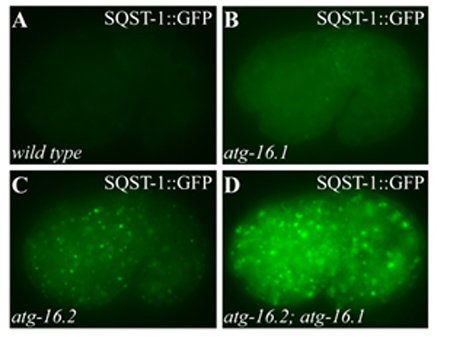中科院研究阐明线虫同源基因atg-16遗传和生化作用
2013年9月24日,中国科学院生物物理研究所的张宏课题组在线发表了论文,刊在《Autophagy》杂志上。该研究对线虫同源基因atg-16进行深入的遗传和生化分析,阐明了Atg16在多细胞生物中的功能。
课题名为“The two C. elegans ATG-16 homologs have partially redundant functions in the basal autophagy pathway”。张宏课题组利用线虫作为模式生物进行遗传筛选,通过两个不同的筛选模型,得到了线虫的两个atg-16的同源基因:atg-16.1和atg-16.2。实验证明atg-16.1和atg-16.2在自噬通路以及自噬相关通路中共同发挥作用,其中atg-16.2发挥主要作用。
此外,通过对atg-16突变体中LGG-1/Atg8的表达模式和表达水平的分析,证明了线虫atg-16并不参与LGG-1的脂化作用,而是对已经进行脂化作用的LGG-1的定位发挥作用。ATG-16与ATG-5/LGG-3形成复合体。我们分析比较了atg-5突变体中LGG-1的表达模式和表达水平,结果显示与atg-16的作用不同,atg-5参与了LGG-1的脂化作用。
本项研究以线虫为多细胞模式生物,利用遗传生化分析手段分析了泛素类似结合体系复合体lgg-3-atg-5-atg-16中各个蛋白的具体功能的异同。比较深入的了解Atg16在高等生物自噬通路上的作用机制。
该项研究工作是由张宏课题组的张慧博士完成。该工作得到了国家重点基础研究发展计划(973计划),国家自然科学基金委的资助。张宏博士的研究还获得HHMI国际青年科学家奖支持。

图 atg-16.1和atg-16.2在自噬通路中共同发挥作用
原文链接:
The two C. elegans ATG-16 homologs have partially redundant functions in the basal autophagy pathway
Hui Zhang, Fan Wu, Xingwei Wang, Hongwei Du, Xiaochen Wang, Hong Zhang
The presence of multiple homologs of the same yeast ATGgenes endows an extra layer of complexity on the autophagic machinery in higher eukaryotes. The physiological function of individual homologs in the autophagy pathway remains poorly understood. Here we characterized the function of the two atg16 homologs, atg-16.1 and atg-16.2, in the autophagy pathway in C. elegans. We showed that atg-16.2 mutants exhibit a stronger autophagic defect than atg-16.1 mutants.atg-16.2; atg-16.1 double mutants display a much more severe defect than either single mutant. ATG-16.1 and ATG-16.2 interact with themselves and each other and also directly associate with ATG-5. atg-16.1 mutant embryos exhibit a wild-type expression and distribution pattern of LGG-1/Atg8, while LGG-1 puncta are markedly fewer in number and weaker in intensity in atg-16.2 mutants. In atg-16.2; atg-16.1 double mutants, the lipidated form of LGG-1 accumulates, but LGG-1 puncta are completely absent. ATG-16.2 ectopically expressed on the plasma membrane provides novel sites of LGG-1 puncta formation. We also demonstrated that the C-terminal WD repeats are dispensable for the role of atg-16.2 in aggrephagy (the degradation of protein aggregates by autophagy). Genetic epistasis analysis placed atg-16.2 upstream of atg-2, epg-6and atg-18. Our study indicated that C. elegans ATG-16s are involved in specifying LGG-1 puncta formation and the two ATG-16 homologs have partially redundant yet distinct functions in the aggrephagy pathway.

